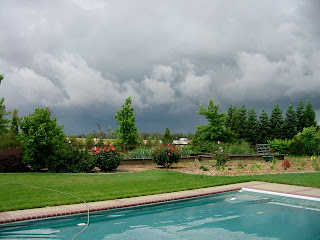GLADS ARE EASY TO GROW
 Most garden soils that will produce a good crop of vegetables or weeds will also grow good glads with little or no added fertilizer. Glads prefer good air circulation and full sunlight but will do reasonably well with a little high shade in early morning or late afternoon. Choose an area with good drainage. Glads don't like wet feet! Raised beds are an ideal solution.
Most garden soils that will produce a good crop of vegetables or weeds will also grow good glads with little or no added fertilizer. Glads prefer good air circulation and full sunlight but will do reasonably well with a little high shade in early morning or late afternoon. Choose an area with good drainage. Glads don't like wet feet! Raised beds are an ideal solution.Plant only clean, plump gladiolus corms (also known as bulbs). Here in the valley, foothills, and Bay Area, plant a few glad corms every week or two, from late January through early April. That way, there will always be a gladiolus in bloom throughout the warm weather months.
Plant gladiolus corms three to five inches deep and from four to six inches apart, with the tip side facing upwards.
 GLADS ARE EASY TO CARE FOR...AND ENJOY
GLADS ARE EASY TO CARE FOR...AND ENJOYWater regularly while they are growing or blooming, perhaps once a week. Water twice a week during heat waves.
Weed by shallow cultivation and hand weeding. A three inch layer of mulch of bark, straw, leaves, grass clippings, etc., between rows will discourage weeds and help conserve moisture.
To get the most enjoyment of glads as a cut flower indoors, cut off the flowering stalk when the lowest buds begin to open. Be sure to keep at least four leaves on the plant to allow the corm to renew itself for the following year.
At the end of the season, cut off the stem just below the lowest flower buds. This keeps the energy from the leaves flowing towards the corm, not to seed production.
GLADIOLUS CAN GET BUGGED
 Thrips are one of the most damaging insects to glads, especially in the summer. Look for silvery flecks on the foliage and silver or brown blemishes on the flowers and buds. You may also see their black droppings on the leaves.
Thrips are one of the most damaging insects to glads, especially in the summer. Look for silvery flecks on the foliage and silver or brown blemishes on the flowers and buds. You may also see their black droppings on the leaves. These tiny (less than 1/20th of an inch long) creatures scrape away the plant tissue, suck the juice and lay their eggs inside. Control thrips with a blast of water from the hose or insecticidal soap. Healthy plants can outgrow thrip damage.
CAN YOU DIG IT? YES, BUT NOT EVERY YEAR
 Here in most areas of California, where the ground doesn't freeze in the winter, you may choose not to dig up your corms. However, disease brought on by too much rain and too cool of a soil, as well as eventual crowding, may reduce the amount and quality of next year's bloom.
Here in most areas of California, where the ground doesn't freeze in the winter, you may choose not to dig up your corms. However, disease brought on by too much rain and too cool of a soil, as well as eventual crowding, may reduce the amount and quality of next year's bloom. It is suggested that you dig and divide your corms every couple of years in the fall, being sure to discard any damaged or diseased corms.
The plant should be separated from the corm as close to the corm as possible, either by hand breaking or cutting with pruning shears.
Store any lifted corms in a cool, dry place, in single layers in a flat or ventilated tray. Then, replant those corms the following February or March.







































